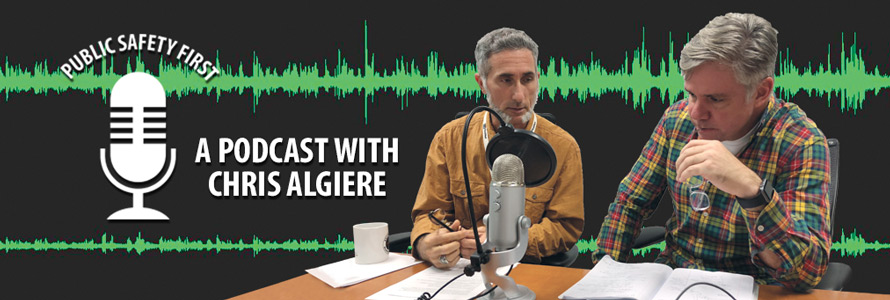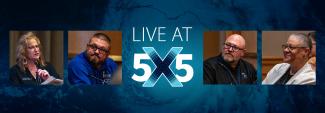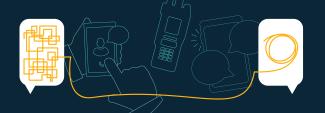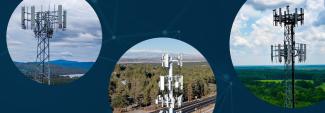Summary
In this episode of Public Safety First, Chris Algiere, FirstNet Authority’s Director of Federal National Programs, joins us to chat about the Public Safety Entity engagement initiative and lessons learned for current FirstNet subscribers like the City of Richmond, and future FirstNet users.
Guest
Dave Buchanan
FirstNet Authority Executive Director of Public Safety Advocacy
Chris Algiere
FirstNet Authority Director of Federal National Programs
Transcript
Preview
Narrator: You're listening to Public Safety First. A podcast to help you learn about the First Responder Network Authority and how you can be part of the future of Public Safety technology.
And now your host, Dave Buchanan
Narrator: You're listening to Public Safety First. A podcast to help you learn about the First Responder Network Authority and how you can be part of the future of Public Safety technology.
And now your host, Dave Buchanan
Dave Buchanan: Welcome to the Public Safety First podcast. Over the last several weeks on previous episodes, we've been interviewing public safety officials and first responders about their use of FirstNet and I've had a number of terrific interviews with first responders across the country about how they're using the First Responder Network to improve their public safety operations. Today we're going to talk a little bit about how the First Responder Network Authority, our office, is working to engage Public Safety. How we're working with those agencies – how we're working with first responders to capture their feedback, so we can continue to improve and enhance their network and their experience with the network. This month marks my fifth anniversary with FirstNet. We started this relationship with first responders back in 2013 when we developed our consultation program long before we had a partnership and long before we had a network. And the principles and the premise behind that program are very similar to the principles we're bringing to our collaboration – to our engagements today. We're going to collaborate with Public Safety. We promise them that they would be integral to the information capture and design of the network. We promise to communicate effectively and communicate regularly with those involved in helping us capture this information and understand Public Safety's needs. And we promise to iterate with Public Safety – be able to share them information as we capture it and analyze it, share them drafts of information, and this collaboration, communication, and iteration approach is one we're going to carry forward as we go into 2018 and 2019 and beyond with our engagement program with Public Safety. The work we are doing, and have already done, and are going to be amplifying, in 2019, builds upon those ideas and those principles. And I'm joined here today by Chris Algiere, our Director of Federal National Programs, and Chris has been with the FirstNet team since 2014 and we've asked Chris to really be the architect of this new program, and this new approach again that builds upon the successes we've had in the past and helps bring about that very similar and critical dialogue with Public Safety, so that we can help again enhance, improve, and bring this network to Public Safety, and help them improve their public safety operations. Welcome to the podcast, Chris!
Chris Algiere: Hey, thanks Dave! It's good to be here.
Dave Buchanan: So, as we talk about engagements and we talk about public safety, I think everyone's well familiar with the campaign we had from 2013 to 2017 on the opt-in program. We consulted with Public Safety. We did a data collection and data capture of Public Safety. We built that information to
RFP – RFP ultimately came an award we made to AT&T to build the network, and together we built state plans that led to the governor's opting-in based on that very feedback and inputs and data collection we got from Public Safety in those, in those first three or four years. Now we've now [been] making a pivot from this state campaign the state plan campaign into an engagement campaign directly with Public Safety and first responders for this new phase of the network, the deployment of the network, and first responders use of the network. Can you talk a little bit about what we've done so far and what we're hoping to achieve with this next phase of our engagement with Public Safety?
Chris Algiere: Hey, thanks Dave! One of the things that we've really wanted to be able to do is, as you said, is to continue to grow our relationship with Public Safety and, more importantly, to really understand and come to a deeper understanding of the missions and the day-to-day operations that are occurring across the public safety landscape. As we built this engagement program, our goal here was to be able to – we wanted to be able to establish a consistent way of engaging with public safety organizations about how they utilize public safety broadband today [and] how they could potentially utilize public safety broadband tomorrow in order for the First Responder Network Authority to continue to advance and innovate in the public safety space by understanding those needs. We also found an opportunity here to allow the public safety organizations to really better understand themselves. By working through the various modules of the workshops and the engagements, they're able to have a consistent and standardized way to capture how they're currently using public safety broadband, the types of organizations and entities that they work with and collaborate with for interoperability and operational needs, as well as their internal and external partners that allow them to actually conduct their operations and to provide communications to their practitioners. The program was built upon activities that were occurring within the FirstNet Authority – as we were going through and having conversations with public safety entities about detailed data use and about how they were configured and operating with their public safety broadband today, as well as with organizations and entities that really wanted to get a better understanding of who their partners would be in executing and delivering their services in a broadband environment as they move forward.
Dave Buchanan: So how are these engagements taking shape? What do they look like to date? Who have we've been involved with, and how is it going as we get started with this?
Chris Algiere: So in order to make sure that what we are delivering is what Public Safety needs, we've instituted a pilot program, where we're conducting some initial pilots with public safety organizations around the United States, both for us to practice and deliver the engagement, as well as to get feedback from the public safety entity about the value of the information that we’re able to gather, and to provide back to them as a product and an output of the engagement. So where we've gone so far is the city of Richmond, Virginia—[we] conducted an engagement there. We've worked with federal entities as well, with the United States Marine Corps and the United States Navy. We have on schedule now plans to engage with the state of Minnesota, and we'll be heading out to Guam and actually conducting our first territorial engagement as well. So through these pilots toward the end of the year we, want to be able to go back, take a look at what we've compiled and what we've put together for a program, and make any necessary adjustments that we might need to be able to do prior to rolling this out full steam in 2019.
Dave Buchanan: And what have we learned to date? You've done a couple already, you mentioned Richmond. I know we did that recently with the federal agencies. What have we learned so far about the way we're delivering these engagements and what have we learned about those agencies’ use of FirstNet or broadband?
Chris Algiere: I think one of the things that we've learned right from the beginning is the complexity of their operational environment, and the missions that they execute within the public safety organizations. We've also learned that there are quite a number of partnerships that they have, both internal to their organization and externally, in order to deliver their communications capabilities. And again, that's where FirstNet sees itself as a future partner in the delivery of that public safety communications capability in broadband. So, as we have gone through and really had the public safety organizations explain to us how they work through their day-to-day operations, it really gives us some insight into all of the elements that allow them from initiation to an event or an occurrence, through closeout, all the steps that are taking place within there. And then also, as part of the conversation with the public safety organization, where there might be opportunity for broadband to increase their capabilities, and maybe provide some streamlining of functions where there may be three or four different ways that they're doing it today, and is there an opportunity there?
Dave Buchanan: So what are these engagements look like for those federal and state, local, and tribal officials that joined us through initial consultation and governance body meetings and executive consultation and consultation task teams? We've tried a number of different formats with a number of different people, different sized meetings, all sort of customized to meet the purpose of the meeting. What does this meeting look like in terms of duration and the people that are – need to be involved? I'm trying to help our listeners picture what this is going to look like as we roll this out full force in 2019.
Chris Algiere: Sure, Dave! So the way the engagements are structured is – we understand that different organizations are going to have a different ability to commit the time needed to work through these. So we intentionally designed them in a modular fashion where we can, we can customize a particular engagement to fit a specific time frame. Ideally, what we're looking at here would be probably two to three hours for a certain portion or a certain segment of a particular engagement, up to full day or beyond. Again, we can scale that based upon the complexity of the group that's brought together. I'll give an example of an engagement that was conducted over a two day period, simply due to the scale of those that were involved. So there was, there was a deal of a great deal of complexity in the discussions that we were having, but generally the flow is one in which we work very closely with the organization ahead of time to make sure that we are customizing and designing that engagement to fit, to fit their need, and to fit the need of the public safety organization. So we work through all of the background administrative work and everything to make sure that when we go in and we deliver that engagement, that the focus is on the public safety organization; the focus is on their learning and the exchange of information, where we as FirstNet are there to really facilitate that conversation. We go in – one of the modules is to discuss and talk about operational and interoperability partners – so we go in there and again facilitate that conversation, allow Public Safety to let us know, and really allow the conversations to take place across the table amongst those that are involved in the meeting, from the public safety entity and from the organization. The next phase of that is: We'll start looking into something a little bit more technical – we do a technology walkthrough. We're able to sit down and take a scenario or a use case, and work through that and identify all of those elements of communications that are taking place from beginning to end, and find opportunities, and also find where maybe there's some gaps in capability that are identified from the group that's assembled there. And so we work through that based upon the timeline that's available, and based upon those that are brought to the table. I think ideally what we're looking for is everyone that is involved in the event, from a practitioner perspective through to a telecommunicator, IT offices, and others that are delivering those services, that really makes it a very robust conversation. It really allows us to dive in to, and allows the public safety organization to learn from each other as we walk through it.
Dave Buchanan: So you mentioned earlier some of the things we're learning and some of the things the agencies are learning when they're bringing what otherwise would be disparate parts of their municipality or their unit of local government together to talk about FirstNet. Can you give me an example of one of those “A-Ha!” moments that's occurred during one of these engagements?
Chris Algiere: Sure. So we had an instance where part of the conversation we were working through an EMS scenario, and part of the discussion, as we were walking through that scenario, centered around electronic patient record keeping. And so it was noted that currently, that organization did not have an electronic patient record keeping capability on their EMS platforms. And so we sort of dug into that a little bit and said, ‘so what's the background and why is an EPRC not available for you?’ And their response was that ‘well our IT office doesn't allow us to do that, because we can't get the credentials and the accreditation for that connection for that wireless broadband connection.’ And it was interesting because we had the IT office representatives across the table. And so they said – so the response from the IT office is one, ‘well we didn't understand that that was a requirement.’ And so it allowed them to have that conversation and actually start down a path where they could resolve that issue where, again, that's not necessarily something that benefits FirstNet – that's something that benefits the organization, where they're able to more efficiently deliver their services to the general public, and to accomplish their mission. So that was probably one of the most outstanding ones that we've had.
Dave Buchanan: And I think that's really exciting. When I've seen this happen just this last year, where agencies are now – now that they have FirstNet their fingertips, and they really are considering what this means for their agency and our ability to help them think about what they need to do to optimize their operations to maximize the use of FirstNet, and really bring it to life in their agencies. I think that's a really exciting thing to happen and I think it's a great spot for us at the First Responder Network Authority to position ourselves really [to] provide that that kind of dialogue, and that kind of leadership across public safety and allow that conversation to happen. And I'm excited that we're going to get to do more of that. Chris, can you talk a little bit more about what we're going to get out of this? What's the First Responder Network Authority going to get from these engagements? What are we going to do with this information, and how’s that valuable to Public Safety?
Chris Algiere: So, all along, we've really wanted to make sure that everything that we do within FirstNet is focused on Public Safety – that were really driven by the needs of Public Safety. And so this platform allows us to take in that information and really better inform decisions that are made internal to FirstNet. As we start looking down the road and as the network matures and continues and deployments happen, there are going to be opportunities for FirstNet to invest in technologies, to increase the capacity and the capability of the network. The information that we gather from Public Safety identifying those areas where they're identifying those opportunities, in those areas where there may be need for improvement or maybe there's, there needs to be a little bit of change and adjustment in the focus of what we're doing. This platform really allows for Public Safety to have that strong voice in what we do and the decisions that we make across FirstNet and across the nation.
Dave Buchanan: And to me, Chris these engagements really become, I think, extraordinarily critical in our relationship and our commitment to collaborate with Public Safety. As we go back and think about those commitments we made five years ago – keep them connected to the improvements and enhancements of this network. These engagements – the other work we're going to do in public safety advocacy – this part of it, I think, is the most important aspect: Our ability to capture that information, to collect that feedback, and to ensure that it's materially considered in how we enhance and invest in the future of the network. I think Public Safety will see a lot of value in that, and I think that's sort of one of the driving forces between the work you and I are doing. What do agencies expect to see at the end of this? Or what would they sort of get out of this at the end of the two hours or eight hours or two days? What does that look like at the end?
Chris Algiere: So throughout the design of this we wanted to ensure that there was something that we were going to give back – that the public safety organization would have something in return for their investment of time. And so what we have are specific products that are developed, coming out of each one of the engagements. So anything from we work through an interoperability and operational partners matrix where we can identify internal and external partners, where those organizations or entities reside, the type of information that is transitioned and transferred between that public safety entity and their partners – so we provide that directly back. As we work through the technology, the technology walkthrough, and use case in scenario, we actually capture that in a Visio diagram that makes it really easy for a public safety organization to turn to their leadership, to turn to their governance groups, and show them the complexity of the things that they're doing and where all the aspects of communications are occurring throughout that particular use case. In the case of the data capture workshops that will be coming online soon and have been executed in pilot, it's a pretty detailed workbook in diagrams and call-outs showing how they have broadband systems installed, how they use them, [and] how they consume data throughout. So, again, we want to be able to, at the end of each one of these, provide some valuable information back to the public safety organization that they're able to use, both to inform themselves if necessary, or to inform leadership or others within their organization or externally.
Dave Buchanan: So as you mentioned we're pilot testing these now. We're training our staff on how to think about and deliver these engagements. We're working with public safety agencies to do, again, beta test to this. Again, our commitment is to adjust, and improve, and enhance the delivery of this, so that they are most efficient for the agency and most efficient for us. When do we expect the pilots to conclude and when do you hope we can begin launching these more robustly?
Chris Algiere: So the pilots will be executed through the remainder of 2018. Again, we have completed one, we've got more scheduled. So we'll work those pilots, and then it'll be a brief period where we just sort of reassess where we are and make sure that, that the information and the process that we're going through is effective and is being well-received. So what we're looking at is, in 2019 – early first quarter 2019 – we really want to be able to start doing these and conducting these in earnest, is our goal at the end of the day.
Dave Buchanan: How does an agency get selected to receive one of these engagements? Can they reach out to us? Will we be identifying them ahead of time or reaching out to them? What's that process look like in your mind at the moment?
Chris Algiere: So the way that we're working at that right now is: we have our field operations staff that's out there interacting with Public Safety today. They have relationships in place where there may be opportunities for them to suggest one of these engagements as a method of further interacting and continuing that consultation process. Public safety entities that are interested in these types of things can reach out to their FirstNet point of contact in the field, or here at headquarters, and request one – request that we hold an engagement. One of the things that we are always conscious of are, is the resource requirements in order to do these. We want to ensure that when we're able to go out that we're doing these effectively, and that there's value in a takeaway. So we're looking for interested parties to make requests. We'll work through that and work with the public safety organization about resourcing and scheduling, and determine what our capacity is to conduct these as we go into 2019.
Dave Buchanan: I think the pilots are really [an] important part of this process, you know? We pilot- tested all forms of our consultation engagements in previous years, and it really gives us an opportunity to fine-tune the approach and make sure we're bringing the right kind of engagement to Public Safety, in the way they're ready to consume it and the way they're ready to engage us. So I appreciate you taking the lead on this Chris. And I'm getting excited that we're headed in that direction. I'm also very proud of the team of, everything we've accomplished already this year: our 22 field staff in five time zones, average about a hundred engagements a month already. Those are individual engagements with public safety professionals, individual engagements with agencies and agency leadership, meetings with our partner and public safety meetings with the professional associations, all in them, again, the spirit in the name of providing information capturing feedback understanding Public Safety's issues and bringing about a meaningful dialogue that allows us to best advocate for Public Safety in this partnership. I know these engagements really will help bring us to an even deeper level with these agencies and bring them even more clarity about how they can optimize FirstNet, and optimize their public safety operations, which is really the whole goal of this. So, I think this is an exciting time for us. I hope it's an exciting time as Public Safety begins to look ahead to what we're going to continue to bring them and, I again, Chris I want to thank you for your leadership on this effort. [I] appreciate the time that's gone into this, and I want to thank the public safety agencies we've already worked with, and those we will work with during this pilot phase for agreeing to go first and giving us the feedback that allow us to fine-tune this.
Narrator: Thanks for listening today. We're excited to have you join our podcast community. Join us for the next episode when Dave gets into what it means to advocate for the future of Public Safety technology and make sure to subscribe on iTunes, SoundCloud, and YouTube. You can learn more about the First Responder Network Authority at FirstNet.gov and learn about FirstNet products and services at FirstNet.com






















